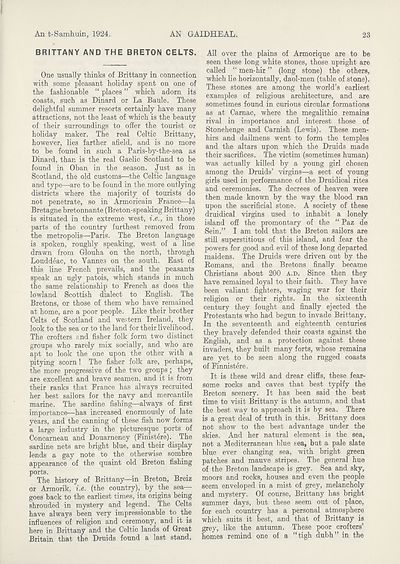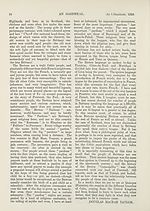An Comunn Gàidhealach Publications > Gaidheal > Volume 20, October 1924--September 1925
(31) Page 23
Download files
Complete book:
Individual page:
Thumbnail gallery: Grid view | List view

An t-Samhuin, 1924.
AN GAIDHEAL.
23
BRITTANY AND THE BRETON CELTS.
One usually thinks of Brittany in connection
with some pleasant holiday spent on one of
the fashionable “ places ” which adorn its
coasts, such as Dinard or La Baule. These
delightful summer resorts certainly have many
attractions, not the least of which is the beauty
of their surroundings to offer the tourist or
holiday maker. The real Celtic Brittany,
however, lies farther afield, and is no more
to be found in such a Paris-by-the-sea as
Dinard, than is the real Gaelic Scotland to be
found in Oban in the season. Just as in
Scotland, the old customs—the Celtic language
and type—are to be found in the more outlying
districts where the majority of tourists do
not penetrate, so in Armoricain France—la
Bretagne bretonnante (Breton-speaking Brittany)
is situated in the extreme west, i.e., in those
parts of the country furthest removed from
the metropolis—Paris. The Breton language
is spoken, roughly speaking, west of a line
drawn from Glouha on the north, through
Louddeac, to Vannes on the south. East of
this line French prevails, and the peasants
speak an ugly patois, which stands in much
the same relationship to French as does the
lowland Scottish dialect to English. The
Bretons, or those of them who have remained
at home, are a poor people. Like their brother
Celts of Scotland and western Ireland, they
look to the sea or to the land for their livelihood.
The crofters fmd fisher folk form two distinct
groups who rarely mix socially, and who are
apt to look the one upon the other with a
pitying scorn! The fisher folk are, perhaps,
the more progressive of the two groups; they
are excellent and brave seamen, and it is from
their ranks that France has always recruited
her best sailors for the navy and mercantile
marine. The sardine fishing—always of first
importance—has increased enormously of late
years, and the canning of these fish now forms
a large industry in the picturesque ports of
Concarneau and Douarneney (Finistere). The
sardine nets are bright blue, and their display
lends a gay note to the otherwise sombre
appearance of the quaint old Breton fishing
ports.
The history of Brittany—in Breton, Breiz
or Armorik, i.e. (the country), by the sea—
goes back to the earliest times, its origins being
shrouded in mystery and legend. The Celts
have always been very impressionable to the
influences of religion and ceremony, and it is
here in Brittany and the Celtic lands of Great
Britain that the Druids found a last stand.
All over the plains of Armorique are to be
seen these long white stones, those upright are
called “ men-hir ” (long stone) the others,
which lie horizontally, daol-men (table of stone).
These stones are among the world’s earliest
examples of religious architecture, and are
sometimes found in curious circular formations
as at Carnac, where the megalithic remains
rival in importance and interest those of
Stonehenge and Carnish (Lewis). These men¬
hirs and dailmens went to form the temples
and the altars upon which the Druids made
their sacrifices. The victim (sometimes human)
was actually killed by a young girl chosen
among the Druids’ virgins—a sect of young
girls used in performance of the Druidical rites
and ceremonies. The decrees of heaven were
then made known by the way the blood ran
upon the sacrificial stone. A society of these
druidical virgins used to inhabit a lonely
island off the promontary of the “ Paz de
Sein.” I am told that the Breton sailors are
still superstitious of this island, and fear the
powers for good and evil of these long departed
maidens. The Druids were driven out by the
Romans, and the Bretons finally became
Christians about 200 a.d. Since then they
have remained loyal to their faith. They have
been valiant fighters, waging war for their
religion or their rights. In the sixteenth
century they fought and finally ejected the
Protestants who had begun to invade Brittany.
In the seventeenth and eighteenth centuries
they bravely defended their coasts against the
English, and as a protection against these
invaders, they built many forts, whose remains
are yet to be seen along the rugged coasts
of Finnistere.
It is these wild and drear cliffs, these fear¬
some rocks and caves that best typify the
Breton scenery. It has been said the best
time to visit Brittany is the autumn, and that
the best way to approach it is by sea. There
is a great deal of truth in this. Brittany does
not show to the best advantage under the
skies. And her natural element is the sea,
not a Mediterranean blue sea, but a pale slate
blue ever changing sea, with bright green
patches and mauve stripes. The general hue
of the Breton landscape is grey. Sea and sky,
moors and rocks, houses and even the people
seem enveloped in a mist of grey, melancholy
and mystery. Of course, Brittany has bright
summer days, but these seem out of place,
for each country has a personal atmosphere
which suits it best, and that of Brittany is
grey, like the autumn. These poor crofters’
homes remind one of a “tigh dubh” in the
AN GAIDHEAL.
23
BRITTANY AND THE BRETON CELTS.
One usually thinks of Brittany in connection
with some pleasant holiday spent on one of
the fashionable “ places ” which adorn its
coasts, such as Dinard or La Baule. These
delightful summer resorts certainly have many
attractions, not the least of which is the beauty
of their surroundings to offer the tourist or
holiday maker. The real Celtic Brittany,
however, lies farther afield, and is no more
to be found in such a Paris-by-the-sea as
Dinard, than is the real Gaelic Scotland to be
found in Oban in the season. Just as in
Scotland, the old customs—the Celtic language
and type—are to be found in the more outlying
districts where the majority of tourists do
not penetrate, so in Armoricain France—la
Bretagne bretonnante (Breton-speaking Brittany)
is situated in the extreme west, i.e., in those
parts of the country furthest removed from
the metropolis—Paris. The Breton language
is spoken, roughly speaking, west of a line
drawn from Glouha on the north, through
Louddeac, to Vannes on the south. East of
this line French prevails, and the peasants
speak an ugly patois, which stands in much
the same relationship to French as does the
lowland Scottish dialect to English. The
Bretons, or those of them who have remained
at home, are a poor people. Like their brother
Celts of Scotland and western Ireland, they
look to the sea or to the land for their livelihood.
The crofters fmd fisher folk form two distinct
groups who rarely mix socially, and who are
apt to look the one upon the other with a
pitying scorn! The fisher folk are, perhaps,
the more progressive of the two groups; they
are excellent and brave seamen, and it is from
their ranks that France has always recruited
her best sailors for the navy and mercantile
marine. The sardine fishing—always of first
importance—has increased enormously of late
years, and the canning of these fish now forms
a large industry in the picturesque ports of
Concarneau and Douarneney (Finistere). The
sardine nets are bright blue, and their display
lends a gay note to the otherwise sombre
appearance of the quaint old Breton fishing
ports.
The history of Brittany—in Breton, Breiz
or Armorik, i.e. (the country), by the sea—
goes back to the earliest times, its origins being
shrouded in mystery and legend. The Celts
have always been very impressionable to the
influences of religion and ceremony, and it is
here in Brittany and the Celtic lands of Great
Britain that the Druids found a last stand.
All over the plains of Armorique are to be
seen these long white stones, those upright are
called “ men-hir ” (long stone) the others,
which lie horizontally, daol-men (table of stone).
These stones are among the world’s earliest
examples of religious architecture, and are
sometimes found in curious circular formations
as at Carnac, where the megalithic remains
rival in importance and interest those of
Stonehenge and Carnish (Lewis). These men¬
hirs and dailmens went to form the temples
and the altars upon which the Druids made
their sacrifices. The victim (sometimes human)
was actually killed by a young girl chosen
among the Druids’ virgins—a sect of young
girls used in performance of the Druidical rites
and ceremonies. The decrees of heaven were
then made known by the way the blood ran
upon the sacrificial stone. A society of these
druidical virgins used to inhabit a lonely
island off the promontary of the “ Paz de
Sein.” I am told that the Breton sailors are
still superstitious of this island, and fear the
powers for good and evil of these long departed
maidens. The Druids were driven out by the
Romans, and the Bretons finally became
Christians about 200 a.d. Since then they
have remained loyal to their faith. They have
been valiant fighters, waging war for their
religion or their rights. In the sixteenth
century they fought and finally ejected the
Protestants who had begun to invade Brittany.
In the seventeenth and eighteenth centuries
they bravely defended their coasts against the
English, and as a protection against these
invaders, they built many forts, whose remains
are yet to be seen along the rugged coasts
of Finnistere.
It is these wild and drear cliffs, these fear¬
some rocks and caves that best typify the
Breton scenery. It has been said the best
time to visit Brittany is the autumn, and that
the best way to approach it is by sea. There
is a great deal of truth in this. Brittany does
not show to the best advantage under the
skies. And her natural element is the sea,
not a Mediterranean blue sea, but a pale slate
blue ever changing sea, with bright green
patches and mauve stripes. The general hue
of the Breton landscape is grey. Sea and sky,
moors and rocks, houses and even the people
seem enveloped in a mist of grey, melancholy
and mystery. Of course, Brittany has bright
summer days, but these seem out of place,
for each country has a personal atmosphere
which suits it best, and that of Brittany is
grey, like the autumn. These poor crofters’
homes remind one of a “tigh dubh” in the
Set display mode to:
![]() Universal Viewer |
Universal Viewer | ![]() Mirador |
Large image | Transcription
Mirador |
Large image | Transcription
| An Comunn Gàidhealach > An Comunn Gàidhealach Publications > Gaidheal > Volume 20, October 1924--September 1925 > (31) Page 23 |
|---|
| Permanent URL | https://digital.nls.uk/125302572 |
|---|
| Description | This contains items published by An Comunn, which are not specifically Mòd-related. It includes journals, annual reports and corporate documents, policy statements, educational resources and published plays and literature. It is arranged alphabetically by title. |
|---|
| Description | A collection of over 400 items published by An Comunn Gàidhealach, the organisation which promotes Gaelic language and culture and organises the Royal National Mòd. Dating from 1891 up to the present day, the collection includes journals and newspapers, annual reports, educational materials, national Mòd programmes, published Mòd literature and music. |
|---|---|
| Additional NLS resources: |
|

